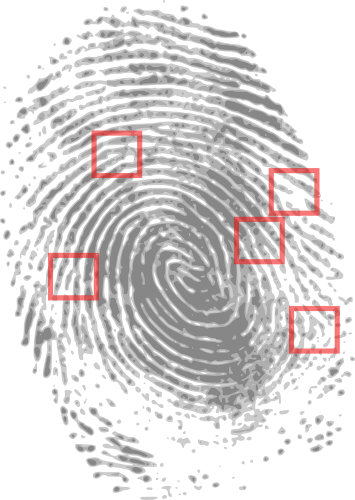
Biometrics is the science that uses people’s biological characteristics to identify them. Fingerprinting is one form of biometrics that investigators can use to confirm or disprove a person’s identity, helping to determine if they were at a crime scene.
13 Fingerprint Facts
- There are three main fingerprint patterns, called arches, loops and whorls. The uniqueness of a fingerprint is determined by the size, shape, number, and arrangement of minor details in these patterns. 1 Other identifying factors within the patterns are deltas, arches, ridge endings, broken ridges, island ridges, forks, dots, spurs, eyes, bifurcations, and other distinguishing marks. 3
- Loops are the most common type of fingerprint and occur 60% of the time. The loop can point either toward the thumb or the little finger.
- Whorls make up about 35% of all fingerprints. They come in several forms and are a circular or spiral pattern.
- Arches are the rarest type of print, accounting for about 5% of the population’s fingerprint. They are in a wavelike shape. 4
- Fingerprints found at the scene of a crime are called a ‘latent print’ or a ‘finger mark.’ Law enforcement cross reference police databases with other fingerprints to find potential links to other crimes and/or suspects. 1
- Fingerprints can also help identify victims following a natural or manmade disaster. 2
- A perfect fingerprint can yield 175 to 180 points of information., Only 12 points are required to convict a suspect in US Federal Court. That is less than ten percent of possible fingerprint points. Many jurisdictions accept as few as five points for a conviction. 3
- Palm and sole prints can also be used to identity people if fingerprints are unclear. 4
- Your fingerprints can reveal what drugs you’ve taken, including opiates, cocaine and cannabis from just one fingerprint sample and can even work on dead bodies. 4
- In 1948, police ordered a mass fingerprinting of all men over 16 in the Lancashire town of Blackburn to catch the person who had killed a child. The 46,253rd set of prints collected belonged to the killer who was identified and hanged. 4
- They form the ridges that create fingerprints on the fingers of a fetus in weeks 10-15 of gestation 4 and are complete by the seventh month. 3
- No two people have the same fingerprints, not even identical twins. 1
- Some people are born without fingerprints. 4
- Fingerprints are more than skin-deep and therefore almost impossible to permanently remove. 4
- Ancient fingerprints have been preserved for thousands of years 4
- Koalas have fingerprints so close to ours that they could confuse the police 4
Resources:
- Interpol, “Fingerprints.” https://www.interpol.int/en/How-we-work/Forensics/Fingerprints#:~:text=No%20two%20people%20have%20the,called%20arches%2C%20loops%20and%20whorls.
- Interpol Fingerprint Factsheets. file:///C:/Users/Ida/Downloads/FS-03%20FingerPrint%20Factsheets_EN_2020-03.pdf
- National Child Identification Program – “Facts about fingerprints—What Makes Fingerprints Unique?” https://childidprogram.com/facts-about-fingerprints/#:~:text=Fingerprinting%20is%20one%20of%20the,formed%20seven%20months%20after%20conception
- Tensor – “Ten facts about fingerprints” https://www.tensor.co.uk/blog/news/10-facts-about-fingerprints